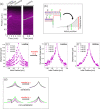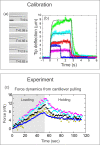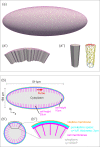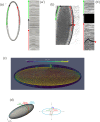A comprehensive model of Drosophila epithelium reveals the role of embryo geometry and cell topology in mechanical responses
- PMID: 37782009
- PMCID: PMC10584372
- DOI: 10.7554/eLife.85569
A comprehensive model of Drosophila epithelium reveals the role of embryo geometry and cell topology in mechanical responses
Abstract
In order to understand morphogenesis, it is necessary to know the material properties or forces shaping the living tissue. In spite of this need, very few in vivo measurements are currently available. Here, using the early Drosophila embryo as a model, we describe a novel cantilever-based technique which allows for the simultaneous quantification of applied force and tissue displacement in a living embryo. By analyzing data from a series of experiments in which embryonic epithelium is subjected to developmentally relevant perturbations, we conclude that the response to applied force is adiabatic and is dominated by elastic forces and geometric constraints, or system size effects. Crucially, computational modeling of the experimental data indicated that the apical surface of the epithelium must be softer than the basal surface, a result which we confirmed experimentally. Further, we used the combination of experimental data and comprehensive computational model to estimate the elastic modulus of the apical surface and set a lower bound on the elastic modulus of the basal surface. More generally, our investigations revealed important general features that we believe should be more widely addressed when quantitatively modeling tissue mechanics in any system. Specifically, different compartments of the same cell can have very different mechanical properties; when they do, they can contribute differently to different mechanical stimuli and cannot be merely averaged together. Additionally, tissue geometry can play a substantial role in mechanical response, and cannot be neglected.
Keywords: D. melanogaster; computational biology; developmental biology; early Drosophila embryo; epithelial morphogenesis; immersed boundary method; stiff and floppy networks; systems biology; tissue mechanics.
Conflict of interest statement
MC, JT, MO, KD, SB, CZ, KM, KD No competing interests declared
Figures














Update of
- doi: 10.1101/2022.08.12.503803
References
-
- Boffi D, Gastaldi L. A finite element approach for the immersed boundary method. Computers & Structures. 2003;81:491–501. doi: 10.1016/S0045-7949(02)00404-2. - DOI
-
- Boffi D, Gastaldi L, Heltai L. Numerical stability of the finite element immersed boundary method. Mathematical Models and Methods in Applied Sciences. 2007;17:1479–1505. doi: 10.1142/S0218202507002352. - DOI
Publication types
MeSH terms
Grants and funding
LinkOut - more resources
Full Text Sources
Molecular Biology Databases

